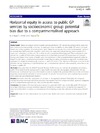Identificador persistente para citar o vincular este elemento:
https://accedacris.ulpgc.es/jspui/handle/10553/58402
| Campo DC | Valor | idioma |
|---|---|---|
| dc.contributor.author | Negrín, M. A. | en_US |
| dc.contributor.author | Pinilla, J. | en_US |
| dc.contributor.author | Abásolo, I. | en_US |
| dc.date.accessioned | 2019-12-15T11:19:58Z | - |
| dc.date.available | 2019-12-15T11:19:58Z | - |
| dc.date.issued | 2019 | en_US |
| dc.identifier.issn | 1475-9276 | en_US |
| dc.identifier.other | Scopus | - |
| dc.identifier.uri | https://accedacris.ulpgc.es/handle/10553/58402 | - |
| dc.description.abstract | Background: Horizontal equity in access to public general practitioner (GP) services by socioeconomic group has been addressed econometrically by testing the statement "equal probability of using public GP services for equal health care needs, regardless of socioeconomic status". Based on survey data, the conventional approach has been to estimate binomial econometric models in which when the respondent reports having visited a public GP, it counts as 1, otherwise it counts as 0. This is what we call a compartmentalised approach. Those respondents who did not visit a public GP but visited instead another doctor (specialist or private GP) would count as 0 (despite having used instead other modes of health care), thus conclusions of the compartmentalised approach might be biased. In such cases, a multinomial econometric model -that we called comprehensive approach- would be more appropriate to analyse horizontal equity in access to public GP services. The objective of this paper is to test for this potential bias by comparing a compartmentalised and a comprehensive approach, when analysing horizontal equity in access to public GP. Methods: Using data from the 2016/17 Spanish National Health Survey, we estimate the probability of visiting a public GP as determined by socioeconomic status, health care need and demographic characteristics. We use binomial and multinomial logit and probit models in order to highlight the potential differences in the conclusions regarding socioeconomic inequities in access to public GP services. Socioeconomic status is proxied by education level, social class and employment situation. Results: Our results show that conclusions are sensitive to the approach selected. Particularly, the horizontal inequity favouring individuals with lower education that resulted from the compartmentalised approach disappears under a comprehensive approach and only a social class effect remains. Conclusion: An analysis of horizontal equity in access to a particular health care service (like public GP services) undertaken following a compartmentalised approach should be compared with a comprehensive approach in order to test that there is no bias as a consequence of considering as zeros the utilisation of other types of health care. | en_US |
| dc.language | eng | en_US |
| dc.relation.ispartof | International Journal for Equity in Health | en_US |
| dc.source | International Journal for Equity in Health [ISSN 1475-9276], v. 18 (187) | en_US |
| dc.subject | 531207 Sanidad | en_US |
| dc.subject.other | Public GP visits | en_US |
| dc.subject.other | Horizontal equity in access | en_US |
| dc.subject.other | Bias | en_US |
| dc.subject.other | Health care services | en_US |
| dc.subject.other | Specialist visits | en_US |
| dc.subject.other | National health surveys | en_US |
| dc.title | Horizontal equity in access to public GP services by socioeconomic group: Potential bias due to a compartmentalised approach | en_US |
| dc.type | info:eu-repo/semantics/article | en_US |
| dc.type | Article | en_US |
| dc.identifier.doi | 10.1186/s12939-019-1091-2 | en_US |
| dc.identifier.scopus | 85075916837 | - |
| dc.identifier.isi | 000501161600002 | - |
| dc.contributor.authorscopusid | 9249657200 | - |
| dc.contributor.authorscopusid | 7005595836 | - |
| dc.contributor.authorscopusid | 6602352170 | - |
| dc.identifier.eissn | 1475-9276 | - |
| dc.identifier.issue | 187 | - |
| dc.relation.volume | 18 | en_US |
| dc.investigacion | Ciencias Sociales y Jurídicas | en_US |
| dc.type2 | Artículo | en_US |
| dc.contributor.daisngid | 31500350 | - |
| dc.contributor.daisngid | 1717005 | - |
| dc.contributor.daisngid | 2369703 | - |
| dc.description.numberofpages | 12 | en_US |
| dc.utils.revision | Sí | en_US |
| dc.contributor.wosstandard | WOS:Negrin, MA | - |
| dc.contributor.wosstandard | WOS:Pinilla, J | - |
| dc.contributor.wosstandard | WOS:Abasolo, I | - |
| dc.date.coverdate | Diciembre 2019 | en_US |
| dc.identifier.ulpgc | Sí | es |
| dc.description.sjr | 1,393 | |
| dc.description.jcr | 2595,0 | |
| dc.description.sjrq | Q1 | |
| dc.description.jcrq | Q1 | |
| dc.description.ssci | SSCI | |
| item.fulltext | Con texto completo | - |
| item.grantfulltext | open | - |
| crisitem.author.dept | GIR TIDES- Técnicas estadísticas bayesianas y de decisión en la economía y empresa | - |
| crisitem.author.dept | IU de Turismo y Desarrollo Económico Sostenible | - |
| crisitem.author.dept | Departamento de Métodos Cuantitativos en Economía y Gestión | - |
| crisitem.author.dept | GIR Economía de la salud y políticas públicas | - |
| crisitem.author.dept | Departamento de Métodos Cuantitativos en Economía y Gestión | - |
| crisitem.author.orcid | 0000-0002-7074-6268 | - |
| crisitem.author.orcid | 0000-0002-7126-4236 | - |
| crisitem.author.parentorg | IU de Turismo y Desarrollo Económico Sostenible | - |
| crisitem.author.parentorg | Departamento de Métodos Cuantitativos en Economía y Gestión | - |
| crisitem.author.fullName | Negrín Hernández, Miguel Ángel | - |
| crisitem.author.fullName | Pinilla Domínguez, Jaime | - |
| Colección: | Artículos | |
Visitas
84
actualizado el 12-oct-2024
Descargas
107
actualizado el 12-oct-2024
Google ScholarTM
Verifica
Altmetric
Comparte
Exporta metadatos
Los elementos en ULPGC accedaCRIS están protegidos por derechos de autor con todos los derechos reservados, a menos que se indique lo contrario.
